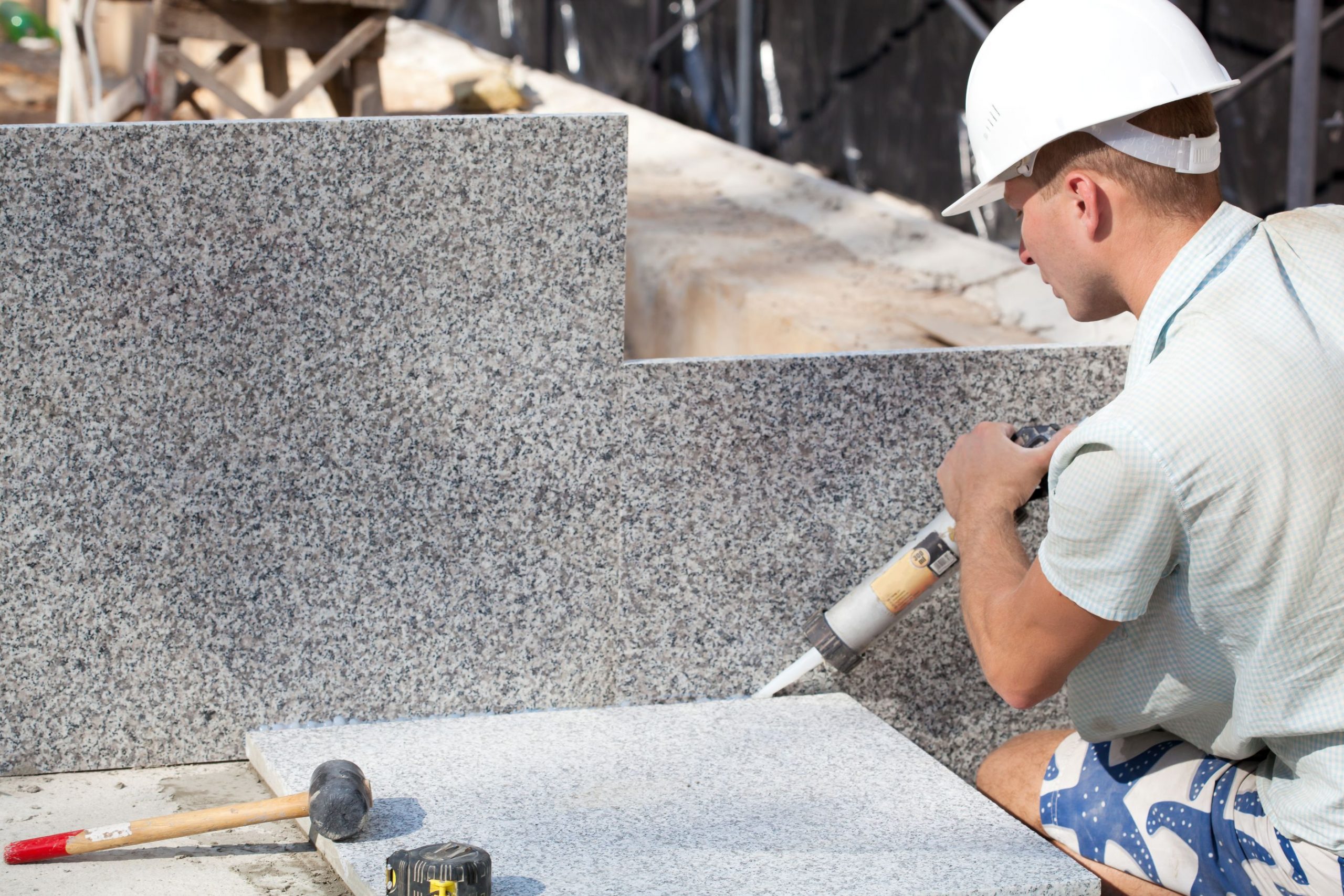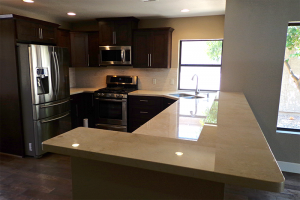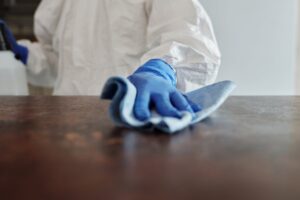-
How to Seal Granite
- Five Things to Know Before Sealing Your Granite
-
Steps on Sealing the Granite
- 1. Clean the Granite First
- 2. Wear Gloves and Keep the Area Well Ventilated
- 3. Experiment in a Small Corner
- 4 . Evenly Apply the Sealer
- 5 . Allow the Sealer to Penetrate
- 6 . If Necessary, Apply a Second Coat
- 7 . Wipe the Sealer Clean
- 8 . Allow 48 Hours for the Counter to Rest
- 9. Take into Account Future Maintenance and Re-sealing
- Selecting and Picking Right Sealant is Essential
- Some Characteristics to Look For in a Sealer
- Variety of Sealants
- Recommendations for Standard Sealing
- Some Tips
- Some Warnings
- Protect Your Investment
Sealing granite countertops is a process that will make your granite shine like new and last for a long time. Many homeowners consider granite tops maintenance when weighing the various countertop material options. Although it does necessitate some upkeep, granite is well worth the effort because the natural stone adds value and beauty to your home. So, how to seal the granite?
If you have a beautiful granite countertop and want to keep it looking like it belongs in a show home, you need to seal it. Some countertops are pre-sealed, but if yours is not, do not wait to give it the protection it requires. Improper cleaning spills left unattended and other daily use issues could easily mark the surface.
They use a penetrating sealer that soaks into the granite and fills the porous gaps to prevent damage. True, a sealant only buys you time—unattended spills will eventually seep through sealed granite—but the right one and the steps for sealing a granite countertop will undoubtedly help protect your investment.
How to Seal Granite
It is critical to look after your granite countertops to keep them looking nice. This solid stone is long-lasting and beautiful, but it requires regular maintenance to keep it protected and look its best.
Five Things to Know Before Sealing Your Granite
1. Granite is a Porous Stone
Granite is a porous stone, despite its hardness and durability. If something spills on the unsealed granite countertops, unsightly marks and permanent stains may result.
During the installation of new granite counters, professionals frequently apply sealant. This sealant, however, wears off over time, which is why reapplication is so essential.
2. Inspect Granite Regularly
Take the so-called “water test” before applying a new coat of sealant by pouring 1/4 cup of water on the countertops. Your counters should not require sealant if the water remains “beaded” on top.
However, if water seeps into the surface or a dark spot appears, you should seal the granite. Make sure to conduct the water test in an inconspicuous area of your kitchen so that it does not leave a visible mark or spot.
3. It is Very Critical to Clean Between Seals
Ideally, you should only need to seal granite every six months, possibly more frequently depending on traffic and use. If something spills on the surface, it is critical to use the proper cleaning methods to avoid further damage. We recommend removing dirt and food debris with a sponge or washcloth and a gentle soap and water. After washing, thoroughly dry with a clean, dry towel.
Avoid using highly acidic solutions or harsh abrasives on your granite countertops, as these can scratch and dull them. Bleach can also dull the surface of the granite. If you must use bleach to disinfect, use it sparingly and make sure it is well diluted. After application, thoroughly rinse the surface.
To remove stains, make a paste of water and baking soda. Gently rub it into the stain with a soft cloth before thoroughly rinsing it away. For particularly stubborn stains, you need to repeat the process several times.
4. Use Non-Toxic, Safe Sealers
When sealing your granite countertops, it is critical to use a non-toxic product. A good sealer should not contain harsh chemicals which can irritate the skin or emit strong odors, and it should not require the use of gloves or masks to apply.
Anything containing harsh chemicals may cause more harm than good. Look for a gentle and effective sealer on your counters. You do not have to worry about dangerous ingredients getting into your food or lingering chemical odors permeating your home.
5. For Best Results, Use Sealant Correctly
Granite sealant should always be applied to clean, dry countertops. To ensure proper application, carefully follow the manufacturer’s instructions.
Apply the sealer evenly from side to side, back to front, and over the edges to ensure that it covers the entire surface. To ensure no spots are missed, section off areas of the countertop and apply one at a time. Allow the sealer to absorb the granite for a few minutes before wiping away any excess. This simple procedure will protect and enhance the appearance of your countertops.
Steps on Sealing the Granite
1. Clean the Granite First
Wipe the granite clean with water and dish soap or a specialized stone cleaner, then dry with a lint-free cloth or towel. Degrease the area first, then clean it thoroughly with denatured alcohol. Allow 24 hours for the granite to completely dry and return to its original color before proceeding, or 8 hours if a strong breeze blows across it.
It is best to wait until the counters are finished if they were just installed or other construction projects are in the same room. Construction dust can obstruct the sealer’s protection.
2. Wear Gloves and Keep the Area Well Ventilated
When applying solvent-based sealers, open the window and put on a pair of gloves to avoid inhaling unpleasant or harmful vapors. Do not be concerned; the sealer will not leave any toxic chemicals in your kitchen.
3. Experiment in a Small Corner
Select an obscure corner of your granite, such as where you usually put a microwave or other appliances. To ensure that the sealer matches the granite, test it on a small area first. Find a different product if the sealer discolors the granite or leaves a hazy residue.
The advice in the preparation should prevent the majority of these issues. The extreme variety found in granite surfaces makes it impossible to eliminate the possibility.
4 . Evenly Apply the Sealer
If the sealer is not in the spray bottle, use a completely clean, sealer-dampened, lint-free cloth or brush to cover the entire surface evenly. The surface should be slightly damp but not soaked.
5 . Allow the Sealer to Penetrate
Check your instructions for the exact minute, as too much time can result in discoloration. The sealer should soak into the stone in about 20 minutes, but trust the label on this one.
6 . If Necessary, Apply a Second Coat
If the label instructs you to apply a second coat, do so when the first one is nearly dry but not completely dry. To ensure even application, wipe this all over the surface.
7 . Wipe the Sealer Clean
Wipe up any remaining sealer with a clean rag after leaving the sealer on for twenty minutes or as long as the label specifies. A haze can form if you leave too much sealer on the counter.
8 . Allow 48 Hours for the Counter to Rest
Another number varies depending on the product, but the sealer must “cure” for some time before you can use your counter. Although some products cure in an hour or two, keeping the counter clean for the first 48 hours is still a good idea.
9. Take into Account Future Maintenance and Re-sealing
Many granite installers recommend resealing every year, but this is not always necessary. There are different frequencies required for different types of stones. Cleaning the surface with products containing ioSeal Protectants, which progressively seal to maintain and enhance your surface’s protection, can also eliminate the need to reseal.
Various factors determine the frequency with which the surface needs for you to seal. The most critical factors are color, porosity, sealer quality, and whether or not you used ioSeal.
Selecting and Picking Right Sealant is Essential
The deeper the sealer penetrates the material’s surface, the better it will resist stains, keep bacteria at bay, and clean up with a wet washcloth and mild detergent or a cleaning product designed specifically for your granite.
As a result, look for penetrating stone sealers. Professional contractors use them to seal marble, granite, and slate countertops.
Some Characteristics to Look For in a Sealer
Suppose you, like many others, want to seal and polish your countertops. In that case, there are kits available that include penetrating sealer and everything else you will need to do the job—it even comes with an instructional DVD to make it easier. Mineral-based for maximum defense.
- Applicable to all stone surfaces.
- Per quart, you get 160-180 square feet of coverage.
- Dries clear without the color of the stone changed.
- It dries in 5 to 10 minutes.
- As a result, the surface repels oil and water-based liquids.
Variety of Sealants
Water-based sealants are less harmful to the environment, whereas solvent-based adhesives can penetrate deeper into the stone—though this is arguably only important on polished granite. Look for the active ingredient called “fluorocarbon aliphatic resin” on the water- or solvent-based sealants label. Though the product will be more expensive than those containing siloxane and silicone, fluorocarbon aliphatic resin provides five to ten years of protection versus six months to three years with other sealants.
Furthermore, fluorocarbon aliphatic resins repel oil and water to prevent a salad dressing spill from ruining your granite. A quart of fluorocarbon aliphatic resin sealant covers 150 to 250 square feet depending on the brand. You may need A 24-oz spray bottle of a less powerful solvent to reapply every six months.
You will find general instructions for sealing either type of granite countertop ahead, but specific directions will vary depending on the brand and active ingredients. Follow the sealant’s label instructions and these helpful hints for the best results.
Recommendations for Standard Sealing
Many granite experts advise sealing granite countertops at least once a year. If you frequently cook in your kitchen and use it daily, you may need to reseal the granite regularly. Over the years, stone professionals have given this advice.
With advancements in nanotechnologies and polymers, efficient and long-lasting sealers for granite stain protection are now available, reducing the need for yearly sealer applications to granite countertops.
Maintaining your granite counters can also influence the frequency it needs to be resealed. You will need to reseal the granite more frequently if you use chemicals that weaken or wear away the sealant.
Some Tips
The protection can last from one to fifteen years, depending on the quality of the sealer and the granite’s color. Repeat the water test to see if more sealer is needed, or reapply whenever you notice spilled water immediately darkening the granite. Never reapply without first performing a water test.
If a sealer leaves a haze on your granite, add a little more of the same solvent to re-dissolve the dried, hazy sealer, then wipe it away as soon as possible. If this doesn’t work, you’ll have to use a micro-abrasive cleaner or a solvent to strip the granite surface.
Some Warnings
No penetrating sealer is “stain-proof,” but they can give you enough time to clean up spills before the counter is damaged. A stain-proof top sealer is terrible for granite counters because stone needs to “breathe” to avoid cracking and other damage.
A sealer will not protect against etching caused by a chemical reaction between some stones and acidic liquids. To repair this damage, you’ll need a specialized etch removal product.
Protect Your Investment
You can enjoy the granite countertops without worrying about every splash of tomato sauce or spill of red wine if you use the right products and take proper care of them. Keep these methods and suggestions to gleaming your granite countertops safe, clean, and protected.
Contact Granite Dude today for more information on sealing, cleaning, and polishing stone surfaces. We have great granite and quartz expertise. To learn more about what we have to offer, give us a call now!










